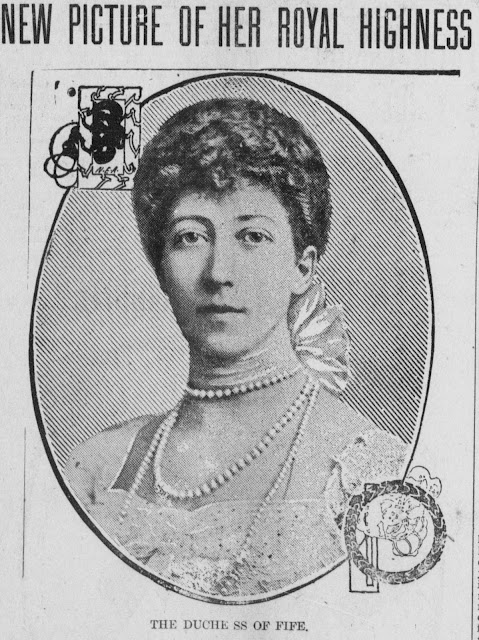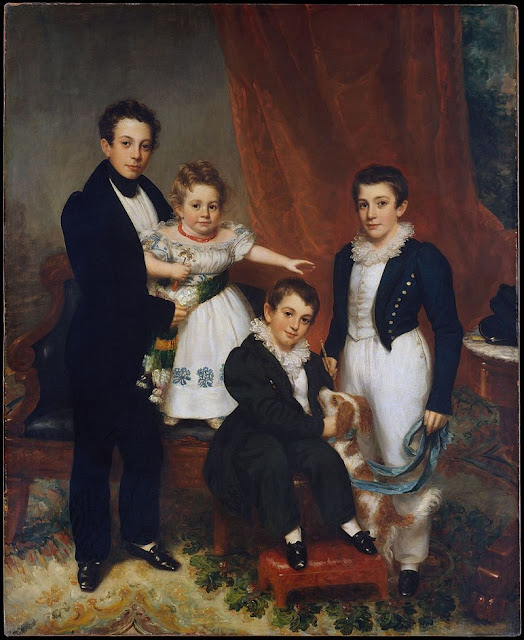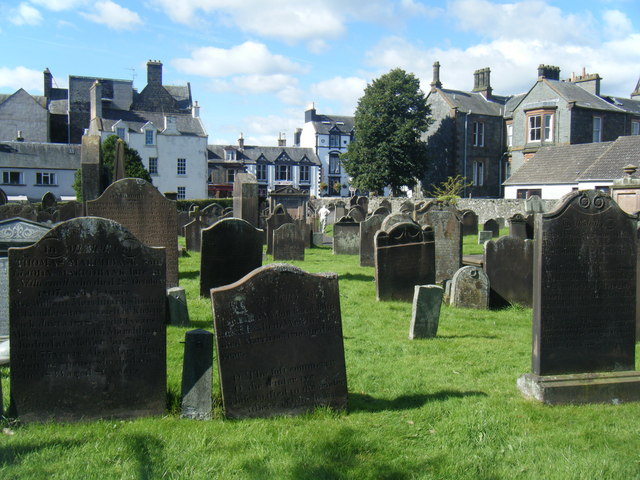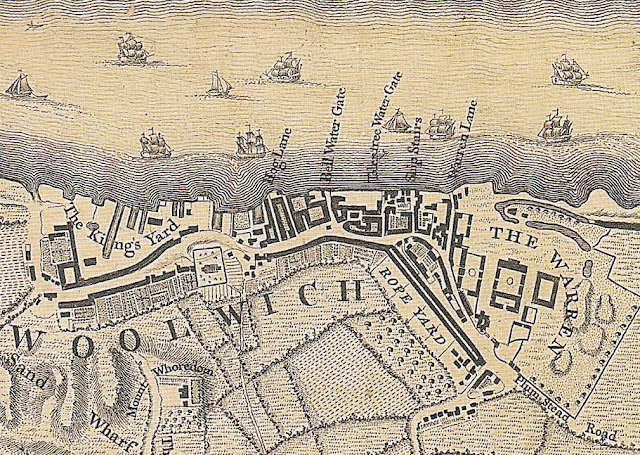This article was first published in Discover Your Ancestors Bookazine, 2018
 |
The Duke
and Duchess of Cambridge leaving hospital with Prince George, after his birth
in July 2013.
Credit: By Ashley
Mott via Wikimedia Commons
|
With the forthcoming birth of a third child to the Duke and Duchess of Cambridge, a child’s position in the pecking order of a family has resurfaced as a popular topic of conversation. Whether the new child will be the youngest of three or a middle child in an even larger family remains to be seen. But what will its position in the birth order signify? And how has pecking order in families – royal or otherwise – mattered in the past?
Alfred Adler (1870-1937), an Austrian psychiatrist was one of the first theorists to suggest that birth order might have an effect on the habitual way in which a person deals with relationships, romantic love and work – some of the key concerns of the family historian. Since then, research into the effects of birth order has been extensive if inconclusive. You might not believe that the position of your ancestor in his or her family mattered to him or her all, but what might have been of significance is the way in which his or her position in the family was perceived by others and, in particular by his or her parents.
It has been suggested (by medical historian Peter Morrell amongst others) that whilst first-born children have only to negotiate with their parents, and second-borns tend to develop close and exclusive relationships with both their parents and first-borns, third-borns (and indeed subsequent children) arrive into a family structure which is already well established and which they can do little to alter. Knowing that if they take sides, the family dynamics might overbalance, a third-born child is characteristically adept at negotiation. always looking for ways to make sure that everyone gets on and that his or her own position is happy and safe through strategic rather than through direct means. According to Morrell, since a third born child is pre-programmed not to put his or her own needs first, his or her life is often built around service of some sort or another. Whilst third-borns can be hesitant and unsure, they are also communicators and diplomats, sensitive to the needs of others but able to steer matters to their own advantage. As a result, third-borns tend to make good strong relationships outside the family, including varied friendships and good marriages. They are good at managing difficult relationship problems both at work and at home – or so some theorists would have it.
Of course, the actual position of child in a family can’t be seen in isolation from the overall size of the family, the gaps in ages between the children and the gender configuration. In the case of the British Royal Family, where until very recently boys always took precedence over girls regardless of birth order in the matter of the succession, gender has always been the key defining factor of a child’s experiences. As a result of the Succession to the Crown Act 2013 (which replaced male-preference primogeniture with absolute primogeniture), the new royal baby will take its place as fifth in line to the throne and will not supersede its older sister Princess Charlotte to that title whether it is a boy or a girl.
Princess Alice -Third-Born Child of Queen Victoria
and Prince Albert
Princess Alice (25th
April 1843 - 14th December 1878) came into this world after her
sister Victoria (b. 1840), and her brother Bertie (later Edward VII, b. 1841). Although
a girl, Louise was no disappointment to her parents because the succession of a
male heir had already been secured. Very soon any thought that she might ever
succeed to the throne was dissipated as one by one her six younger siblings
(three of them boys) were born.
 |
Princess Alice
Princess
Alice, third child and second daughter of Queen Victoria and Prince Albert,
leaning on a chair,1860s.
Credit: William & Daniel Downey, Wikimedia Commons
|
Alice’s adult life certainly fits that of a text-book third-born in that it was entirely devoted to service both to her family and to society. After nursing her father Prince Albert in his final illness (December 1861), she spent the next six months being unofficial secretary to her grief-stricken mother. In her later life Alice supported women’s causes and was interested in nursing. During the Austro-Prussian War of 1866 she helped to manage field hospitals despite being heavily pregnant. Indeed, the Princess Alice Women's Guild, took over much of the day-to-day running of the military hospitals in the Grand Duchy of Hesse over which she presided as Duchess. In 1878, Alice nursed her family with diphtheria for over a month before contracting the disease herself and eventually dying from it.
Louise, Princess Royal – Third-Born Child of Edward VII and Queen
Alexandra
Louise (20 February 1867 – 4 January
1931) was the third of the six children of King Edward VII and Queen Alexandra.
She was, however, the oldest of the family’s three daughters and her position
in the family was further strengthened by the death of her only younger male
sibling Alexander John (after only a day of life) in 1871.When Louise’s elder brother
Albert Victor died suddenly in 1892 and her second brother George had typhoid
and looked likely to die at around the same time, it seemed, for a short while,
that Louise might one day become Queen. Once George recovered, married and had
issue this possibility disappeared but Louise had effectively already significantly
moved up the pecking order of the family.
The importance of her position was
properly recognised on 9 November 1905 when her father, then King Edward VII,
created her the Princess Royal and made her two daughters princesses. Widowed
in 1912, Louise went on to take on some pretty prestigious titles – suitable to
her new position in the family - in the second half of her life. including colonel-in-chief
of the 4th and 7th Dragoon Guards.
 |
Louise
Princess Royal
Louise,
Princess Royal and Duchess of Fife, third child of Edward VII, in late
1903/early 1904
Credit: Tacoma Times,
Wikimedia Commons |
Mary, Princess
Royal - Third-Born Child of George V and Queen Mary
Mary (25th April 1897 – 28 March 1965) was
the only girl amongst five brothers. Her life of service – like the others - seems
to fit with that characteristic of third-borns. During the First World War she helped
British servicemen and their families by visiting hospitals and other welfare
organisations. She was honorary President of the Girl Guide Association from 1920
until her death. She also supported the Voluntary Aid Detachments (VADS) and
the Land Girls and even began a nursing course at Great Ormond Street hospital
in June 1918, working two days a week in the Alexandra Ward. In 1926, she
became commandant-in-chief of the British Red Cross Detachments. The Second
World War saw more service and in 1949, Mary became controller commandant of
the Auxiliary Territorial Service (ATS). In 1950, she became air chief
commandant of Princess Mary’s Royal Air Force Nursing Service and in 1956 she received
the honorary rank of general in the British Army.
It was in her relationships with her family, however, that Mary’s
third-born desire to bring harmony really came to the fore. After the abdication
of her beloved eldest brother Edward VIII in 1937, Mary went to stay with him
at Exenfeld Castle near Vienna though
the rest of the Royal Family strongly disapproved. Later, in March 1965, she even
met her brother’s wife the long-vilified Duchess of Windsor (Wallis Simpson).
Your Ancestor in the Pecking Order
So much for some
Royal third-borns, but you might be more interested in whether the position of
your own ancestor in the family line-up had any effect on the way in which his or her life developed?
British families
were large right up to the last quarter of the nineteenth century. This was for
a variety of reasons - including religion, access to contraception, family
finances and the norms of local cultures. Edwardian households tended to have
between two and four children, with even smaller families becoming the norm between
the two World Wars and from the mid-twentieth century onwards. Whilst
any claims about the significance of pecking order in families need to be made
cautiously, it is worth considering your ancestor in the light of some current
suggestions and the relevant historical background. Here are a few ideas.
·
First-born As children, your first-born
ancestors might have had to stand-in for their parents from a young age. Older children and
especially girls were very much involved in the hands-on care of younger ones. As
well as being the family’s strongest personality or highest achiever, your
first-born ancestor might well have been the one to keep the rest of the pack
under control.
·
Middle-born Less tied to the parents than either
the youngest or oldest children in a family, these ‘in-betweens’ have often been
characterised as ‘rebellious,’ deliberately setting out to do something
different from both their elder and younger siblings.
·
Clusters A pairing off (or clustering) of siblings occurred in some
large families in the past. Close associations, for example, might have developed
between the two eldest children, or between the two youngest.
·
Last-born Whilst
youngest children have sometimes been characterised as the most free-spirited,
self-centred and fun-loving members of the family, it’s worth remembering that
they usually held elder siblings in high esteem and were expected unquestioningly
to obey their authority. Parents might have been more lenient towards younger
children but they also often had unhelpfully lower expectations of them as well.
·
Only Children ‘Lonely
onlies’ in the past might have achieved their status because of maternal or
sibling death. Difficult economic times such
as those between the two World Wars led some parents to feel that they could
afford only one child. An ancestor with no siblings will have enjoyed his or
her parents’ full time, attention and resources and might have been particularly
conscientious or mature for his or her age.
·
Gap Children Ancestors
who came from families where there were big gaps between the ages of the
children might well have lost one or more siblings in infancy or might have
experienced lengthy periods of separation between their parents. In terms of
psychology, a child with (a) much older sibling (s) might be considered on
the same terms as a first-born.
·
Adopted Children Legal adoption began only in 1926 in
Britain, although families had, of course, been informally adopting children
for centuries before this. Some research suggests
that it is the birth order of the biological family rather than the birth
order of the children in the family into which it is adopted that counts as a
child grows up. Other research says that the influence of family position on
adopted children very much depends on the age at which the child was adopted.
·
Multiple
Births The general economic prosperity and nutritional
bounty of the nineteenth century gave rise to more successful multiple births
than in previous history. The number of twins in England and Wales appears to
have nearly doubled between 1841 and 1901. Twins (generally perceived as a
single unit) have a special position in the family which is largely
independent of birth order.
In our search to find out more about our ancestors we should be aware
that their life experiences - wealth,
employment, religion, marital status and geography - probably had the
greatest effect on the way their lives progressed, but birth order is a small
and potentially significant contributing factor that can certainly repay investigation.
|
||
Find
Out More
Davidoff, L., Thicker than Water, Siblings and Their Relations, 1780-1920,
(OUP, 2013).
Garrett E., et al, Changing Family Size in
England and Wales, 1891 –1911, (CUP,
2006).
Hadfield, L., Edwards, R., Lucey H., and Mauther, M., Sibling
Identity and Relationships: Sisters and Brothers, (Routledge, 2006).
Lamb, M.E. and Smith, B. S., Sibling Relationships: Their
Nature and Significance Across the Lifespan, (Lawrence Erlbaum
Associates, 1982).
Morrell, Peter, Family Dynamics and the Third Child
as Outsider http://www.homeoint.org/morrell/misc/thirdchild.htm
Symes, Ruth A. Family
First: Tracing Relationships in the Past, Pen and Sword, 2016
Twitter: https://twitter.com/RuthaSymes
Facebook: https://www.facebook.com/Searchmyancestry/
For women's history and social history books - competitive prices and a great service - visit:
If you have found this article useful please share with friends, family and fellow family researchers using the share icons below: Twitter, Facebook, Email, Google+ and Pinterest |










